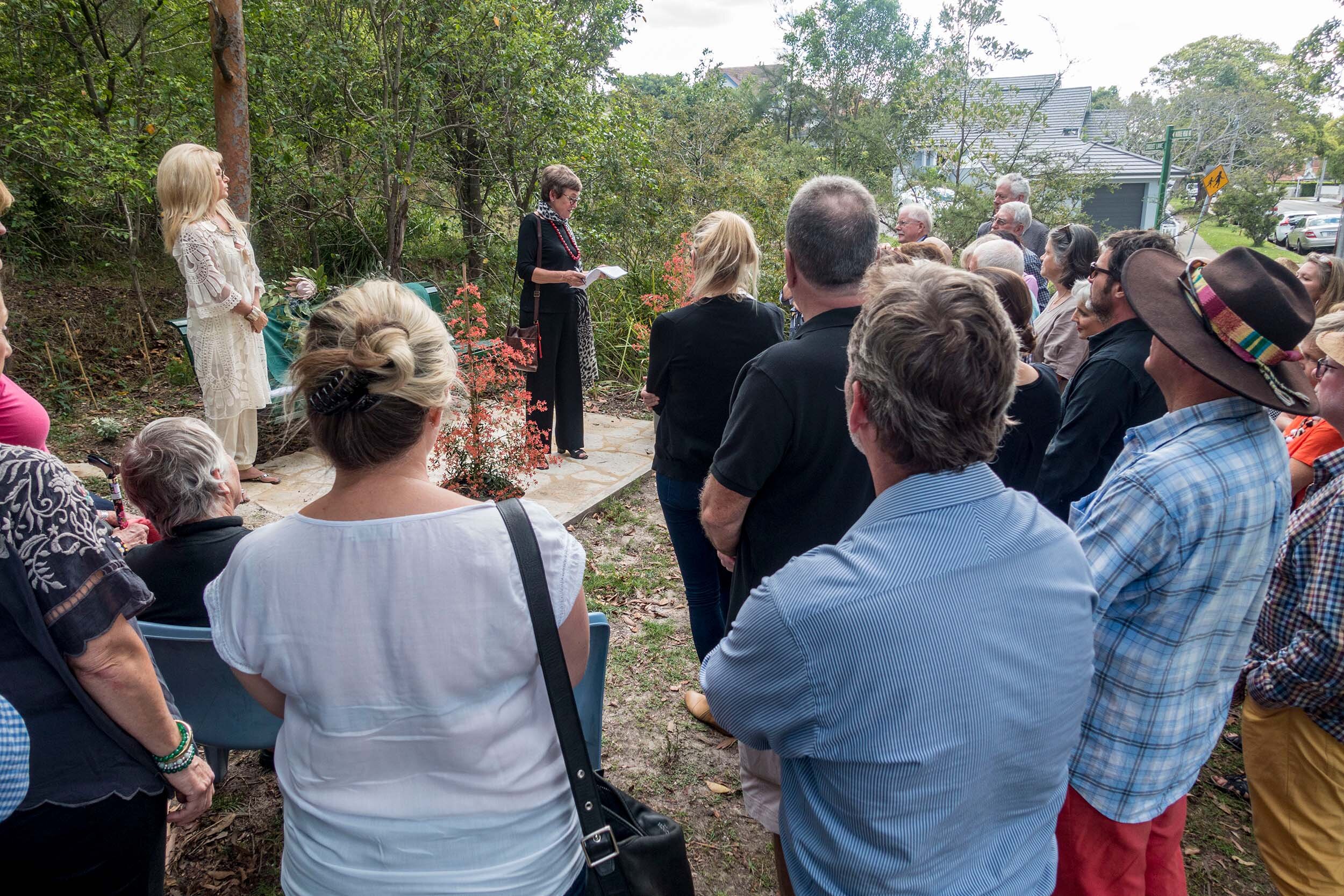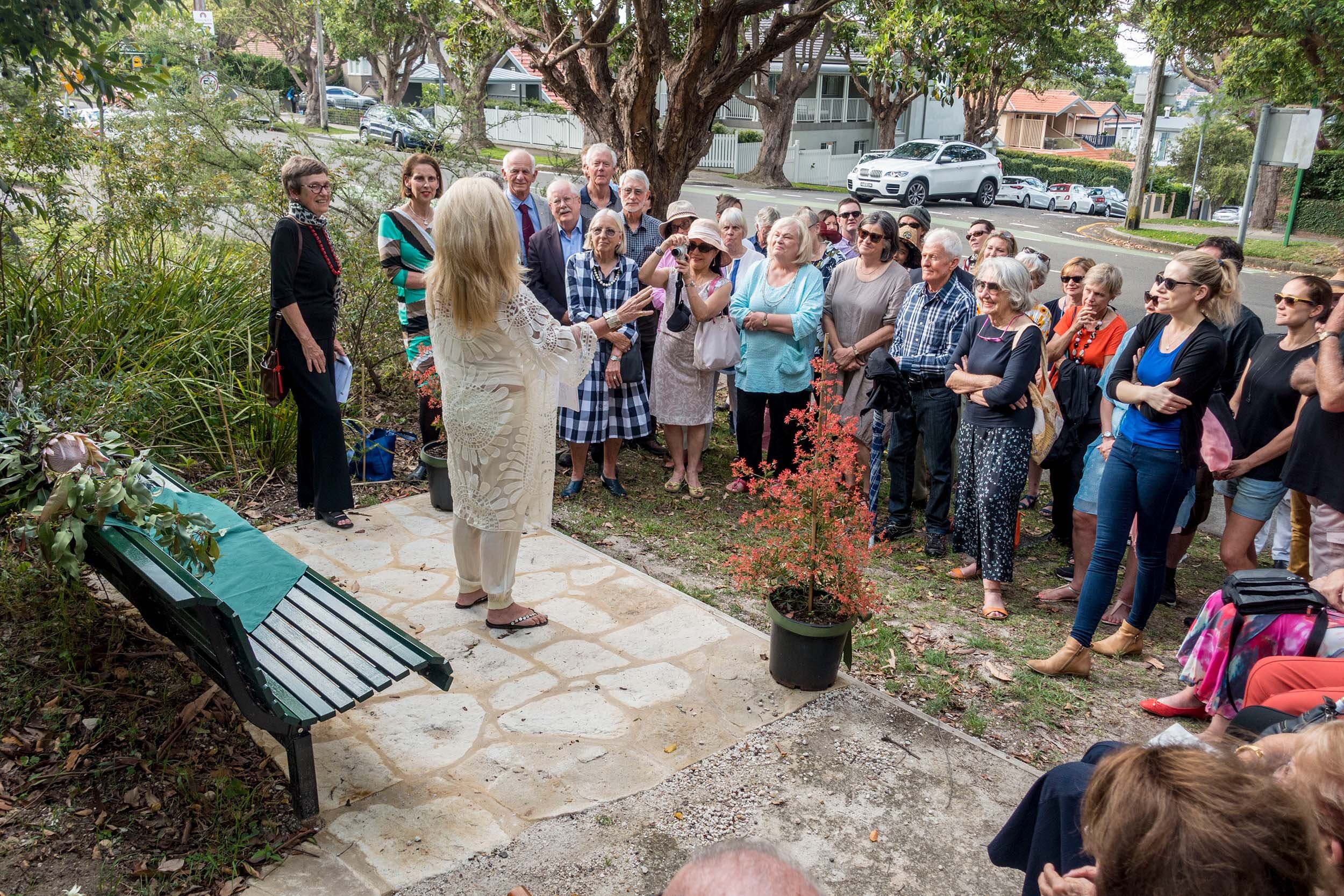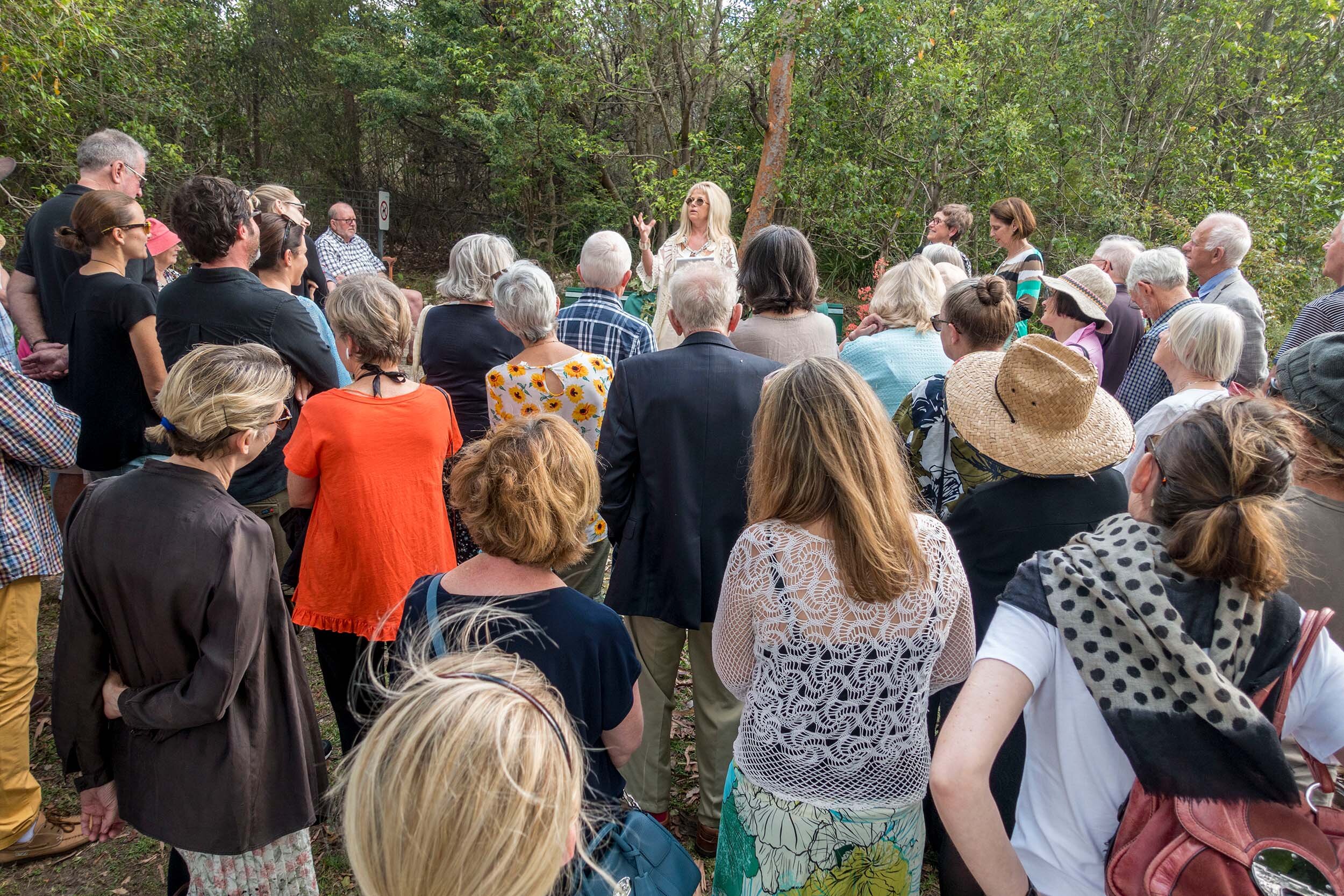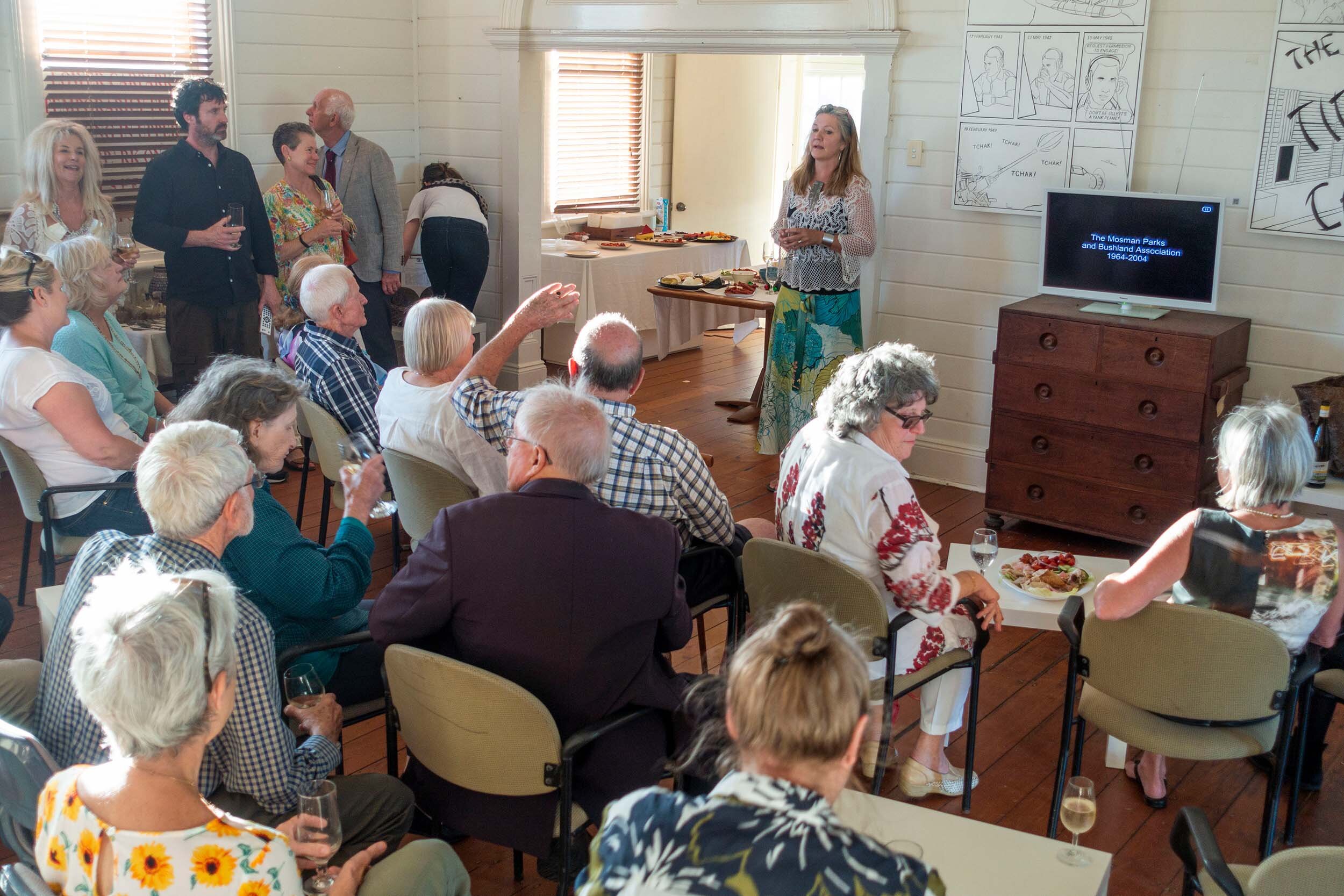Recognising the legacy of Audrey Lenning.
Mosman Parks & Bushland unveiled a plaque dedicated to the memory of Audrey Lenning on 7 December 2017.
ABOVE L-R: Angela Lenning, Carolyn Corrigan, Mayor Mosman Council, Kate Eccles, President Mosman Parks &Bushland Association.
Below is the speech delivered on this occasion by Kate Eccles, President, Mosman Parks & Bushland Association:
I shall begin by acknowledging the traditional owners of this land – the Borogegal and Cammeraygal people of the Eora Nation. As carers and protectors of our parks and bushland it is particularly appropriate to acknowledge the legacy of our first carers of country.
And today we are recognising the legacy of Audrey Lenning who spent more than 50 years of her life learning about that country, the bushland and native vegetation; developing a method to restore it to its condition, prior to the invasion of weeds and non-native species, where native animals and birds could flourish; and to handing on that knowledge to us, her successors.
It's a wonderful legacy
I am Kate Eccles, the president of the Mosman Parks & Bushland Association. It is with pride that the Association, the inheritors of Audrey's legacy, and Audrey's daughter, Angela Lenning and her family welcome you to be part of this ceremony.
We extend a particular welcome to: Cr Carolyn Corrigan, Mayor of Mosman, who will perform the unveiling later along with Audrey's daughter, Angela, and to Cr Jacqui Willoughby. A very big thank you and welcome to Council's Steve Smith, Manager of Environment and Open Space and to Natalie Edmonds, Bushcare Officer. Both have been extremely helpful with organising the seat and in beautifying this part of the Bradley Bushland – an area which we volunteers have found difficult to bring up to a desired standard.
Mary Darwell, Executive Director of the Sydney Harbour Federation Trust (Harbour Trust), our very near neighbour as we stand here – welcome. And Nick Hollo, former Deputy Director of the Harbour Trust who appreciated Audrey's incisive mind, which she put to work for the Harbour Trust.
Mrs Jan O'Keefe (Oh, how we all miss Barry!)
Warrior friends, Phil Jenkyn, Linda Bergin and Brigid Dowsett.
National Parks friends, Mel Tyas and Daz Halloran and thanks to Mel for arranging the use of the Soldiers' Institute.
Welcome to Mosman Parks & Bushland members and it is always good to see former Mosman Parks & Bushland committee members, here today are Deidre McCann, Ken Bloxom, Brian Wilder and of course, Connie Sievers. Now there's a battler!
And especially relevant to today, a member of The Friends of the Bradley Bushland who worked with Audrey and knew the Bradleys, Nell Rickard. Nell probably knows this reserve better than any of us.
Ken Paul of the Chinaman's Beach Action group sent regrets with an acknowledgement of the cooperation between our associations over many years.
Above all, it is our great pleasure and honour to be sharing this day with Audrey's daughter, Angela and her family and friends.
That was a long list, but indicative of the number of people who recognise the importance of Audrey’s work.
That work has two complementary aspects:
the development of a method of bush regeneration and
the recognition of the need to protect bushland and parks from the incursions of development so that city dwellers then, now and into the future could enjoy them - their fresh air, their beauty and peace.
Bush Regeneration
A brief recapitulation of how the principles of bush regeneration were developed, because Audrey was there right from the beginning.
(And I am extremely grateful for the essays and articles by our committee member, Anne Cook for this historical material)
Eileen and Joan Bradley, the Bradley Sisters as they are now known, lived in Iluka Road and Audrey lived just around the corner in Morella Road. Joan and Eileen used to walk their dogs around the bush in that area and they noticed that the bush was full of weeds and that bird numbers were declining – particularly the Superb Fairy Wren and other small birds. It was obvious that the slash and burn methods that were then used to control weeds weren't working. Joan Bradley wrote, “The Council hacked away at Ashton Park. Of course it grew back into lantana practically overnight… (But) As we began to pull away weeds in good bush we could see that the bush began to help itself”
The term ‘bush regeneration’ had not yet been coined however. A paper called “Weeds and Their Control” to which Audrey contributed was published by the Association in 1967 and the Bradleys, Audrey, Barry O'Keefe and others began applying the principles in various Mosman reserves. Apparently Barry used to entertain them by singing funeral dirges in Latin! Audrey described how Bush Regenerating got its name:
“So we started off on Saturday mornings weeding. During a break, discussion came round to our sign “Weeders at Work”. Weeding seemed rather a negative activity, what we were doing had a positive aspect. Ideas and words were tossed around until finally someone said 'regenerator' which was unanimously accepted.” The sign was now to read “Bush Regenerators at Work”. But the sign writer made a mistake which wasn't noticed until several months later when the seven year old Angela, asked “What does regerator mean?”
But while this literal “grass roots” research was happening in bush regeneration, a battle for public land developed. Bushland was bulldozed in Ashton Park on Bradleys Head. (no relation, by the way, to our Bradley sisters) to make an unnecessary road. Local Mosman people were outraged and the result was the formation of The Ashton Park Association which later morphed into The Mosman Parks & Bushland Association. Audrey Lenning was a founding member.
Saving public land and the conservation of bushland have continued to go hand in hand in the history of Mosman Parks & Bushland.
Ashton Park was but the first of many campaigns and Audrey’s role was key – both as campaigner and as a bush regenerator.
I had an apology just this morning from a co-campaigner “I really valued her years of experience and her calm and wise counsel at difficult times when all seemed lost”
During the 1970s Association members Audrey, Joan Bradley and June Gram got behind the Kelley’s Bush campaign at Woolwich. The story was told by one of the Battlers for Kelley’s Bush, of how she rose nervously to talk at the first Battlers’ meeting and saw the faces of our Association members “radiating encouragement” from the front row. They continued to attend the meetings, giving advice from their experience at Ashton Park and presenting a copy of the Association’s book, “Bush Regeneration”.
Audrey – a constant advocate and negotiator
At Mosman Council Audrey was a constant advocate for public land and bushland, gaining respect for her knowledge, and intelligent insights. In those earlier times bushland was not valued as it is now by our recent and current Council. In those days the Council was divided into two camps, those trying to preserve the bushland and leafiness of Mosman, and those who suggested that if people wanted trees they should go and live in the mountains. Beryl Randall, one of the Friends of the Bradley Bushland Reserve said recently, “Noone now remembers how bad it was ! But Audrey was never afraid to speak up”.
She was an effective negotiator with government departments at all levels, diplomatic, but determined and she never gave up.
From 2002 to 2007 she was a respected member of the Community Advisory Committee to the Sydney Harbour Federation Trust.
She was secretary of Mosman Parks & Bushland for many, many years.
Over the years she has contributed to various publications, “Weeds and Their Control”, MPBA’s own publication “Bush Regeneration” with the beautiful drawing of Themeda Australis on its cover. There will be copies of this publication at the Soldiers' Institute and we would be pleased for everyone to have one.
Best known of the publications is “Bringing Back the Bush” by Joan Bradley edited by Audrey, Joan Larking and Jean Walker. It is out of print, but still used. Joan Larking told me how the editing happened. Audrey, Joan Larking and Jean received a suitcase full of sentences from Joan Bradley.
Joan Larking collated them; Jean did the drawings; Audrey was the wordsmith.
I think Angela will tell you about her memories of papers – everywhere – always.
When Angela and I began looking around for a suitable place for a memorial to Audrey, we couldn't believe our luck when we realised that there was no plaque yet on this seat. You see the Bradley Bushland Reserve has become almost sacred ground.
With Anne Cook's permission I would like to read to you part of Anne's article about this reserve.
Many local conservationists were particularly devoted to the 6 acres of sandstone heathland that survived at the top of the ridge at Rawson Park, just east of and below the oval, the only example of that vegetation community remaining in the district. Some, like Audrey Lenning, an original member of the association had enjoyed it as a child, walking to and from school among the Boronias, Banksias, Grevilleas and flannel flowers, to name but a few of the 140 plant species which survived there.
Mosman conservationists had viewed with alarm proposals over the years to develop the site as a hospital, school or playing fields and so when it was proposed that various harbourside parks and bushland reserves be incorporated into a new Sydney Harbour National Park they hoped that the bushland of Rawson Park would be included and its future thus assured.
But a few days after Christmas in 1974 the local council in a brazen act of barely legal skullduggery rushed through a motion after midnight to allow bulldozing of the higher part of the site for netball courts and a section of the lower part for tennis courts. Audrey Lenning and Cr Toni May got wind of this and early the next morning there was a flurry of phone calls between conservationists and telegrams between Mosman and state and federal parliament.
But the women, men and children who gathered to protest on the site were no match for the bulldozer, on which the then mayor was triumphantly riding! The Bradley sisters chose to stay at home and not bear witness to the destruction.
What was left after this exercise of bulldozing at Rawson Park was one hectare, about a third of the original, which association members were determined to preserve, despite it being so reduced in size.
Audrey, by the way, kept up the fight for the Bradley Bushland and years later saw to it that drainage from the top was managed so that the Bradley Bushland could survive.
After Joan’s death in 1982 The Mosman Parks and Bushland Association lobbied to have the bushland dedicated as a reserve to the memory of the Bradley sisters and a group was formed from people all over NSW, the aim of which was to cherish and develop this memorial. The reserve was named the Bradley Bushland Reserve in 1983 and in 1988 a Commonwealth grant was received to create the Wildflower Walk. I wish time allowed for me to tell you the story of how Barry O'Keefe arrived at the official opening, covered in blood! Perhaps another day….. The Friends of the Bradley Bushland Reserve, with the support of Mosman Council, managed the reserve with great dedication until 2009 when responsibility was handed back to the Council. But the Reserve is still loved. Since 2012 a group of Mosman Parks and Bushland members has been bush regenerating here regularly.
(Audrey was a founding member of the “Friends”, and as Angela will tell you, she spent countless hours working here.)
Above L-R: Connie Sievers (treasurer of MPBA and a vigilant Council watcher for many years), Judith McDonald, Angela Lenning, Jan O'Keefe (widow of Barry), Susan Woods.
That is why we were so pleased to find this spot for Audrey's memorial, at the entrance to the reserve named after her friends and colleagues where she spent so many hours putting the research into practice.
And just nearby on this sign at the beginning of the Heath Track is the story of the development of bush regeneration.
Walk for a while along that track and you will hear wrens! Not the Superb Fairy Wren whose disappearance was the origin of all the Bradley's research, but wrens there are and there is habitat for them.
To conclude – more from Anne Cook
At the formal opening of the reserve in 1988 Milo Dunphy, then director of The Total Environment Centre, spoke eloquently of the importance of community groups as a major force in moving the conservation agenda along and bringing pressure to bear on decision makers. He concluded his talk with this prescient observation:
Today as the implications of the Greenhouse Effect (now called Climate Change) are beginning to occupy us we need the sort of minds that regard an acre of natural bushland as precious, that can nurture it in the tiniest detail and draw general principles from it applicable to millions of acres up and down the country … In other words, we need scientists, educators and community leaders like Joan and Eileen Bradley.
Today we shall add the name of AUDREY LENNING to those community leaders.
7th December 2017





